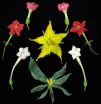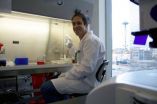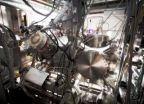(Press-News.org) (SALT LAKE CITY)—In a discovery that can fundamentally change how drugs for arthritis, and potentially many other diseases, are made, University of Utah medical researchers have identified a way to treat inflammation while potentially minimizing a serious side effect of current medications: the increased risk for infection.
These findings provide a new roadmap for making powerful anti-inflammatory medicines that will be safer not only for arthritis patients but also for millions of others with inflammation-associated diseases, such as diabetes, traumatic brain injury, and inflammatory bowel disease, according to cardiologist Dean Y. Li, M.D., Ph.D., the U School of Medicine vice dean for research and HA and Edna Benning endowed professor of medicine who led the study. "This can change the way medication is made," he says. "If we can find a way to replace our most powerful drugs for arthritis, we might be able to develop another way to treat inflammation in other diseases that we've been unable to touch because of the danger of suppressing people's immune systems."
The research, funded by the National Institutes of Health (NIH) and published Sunday, Nov. 11, 2012, Nature online, provides the University the opportunity to explore commercializing the technology either through collaboration outside of the state with pharmaceutical companies or within the state via initiatives such as USTAR. The Utah Legislature established USTAR (Utah Science Technology and Research) initiative in 2006 to promote economic growth and high paying jobs through research at the U of U and Utah State University.
"This is just one example of many scientific opportunities for the University and USTAR to work together to benefit not only millions of patients but build medical innovations in Utah," says Li, who's also director of the U of U Molecular Medicine program.
Two Cellular Pathways
When the body undergoes trauma or gets an infection, it responds by releasing cytokines—proteins that enter cells and unleash a three-pronged attack to kill invading bugs, hype up the immune system, and cause inflammation. While inflammation fights infection, it also produces an undesired side effect by weakening blood vessels, which can lead to swelling in the joints, brain or other areas. Scientists long have believed that cytokines use one cellular pathway in their response to infection, meaning that drugs made to block cytokines from causing inflammation also block the immune system and the ability to kill invading bugs.
In a study with mice, Li and his research colleagues upended the one-pathway belief by showing that cytokines use not one but two cellular pathways to battle infection: one to turn on the immune system and kill intruders and a separate one that destroys the architecture of tissues and organs. Identifying the separate pathway for inflammation has vast potential for developing drugs. "We can selectively block inflammation without making the patient immunosuppressed," Li says. "This rewrites the strategy for today's medicines. We focused the work on arthritis given this is a proven market for drugs that reduce damage from inflammation and fibrosis, but we suspect that many other diseases ranging from fibrosis following heart attacks to inflammatory bowel disease may benefit from such an approach."
Li's discovery has dramatic implications for the field of rheumatology, according to Tracy M. Frech, M.D., U of U assistant professor of internal medicine who specializes in rheumatology. "This may lead to more effective treatments for conditions such as lupus, systemic sclerosis, and the spectrum of inflammatory arthritis, without putting patients at risk for infections," she says. "This phenomenal work is a credit to the strong molecular medicine program here at the University of Utah."
Before a new generation of anti-inflammation drugs can be made, researchers must screen for molecules of chemical compounds that can be turned in pharmaceutical-grade drugs, something the University can and should do, according to Li. This can be accomplished either through collaboration with pharmaceutical companies outside of the state or with sources inside Utah, such as the USTAR initiative.
###
This study was funded by NIH grants:
#R01HL068873
#R01HL077671
#U54AI065357 END
Game changer for arthritis and anti-fibrosis drugs
Discovery shows medications can treat inflammation without increasing risk for infection
2012-11-12
ELSE PRESS RELEASES FROM THIS DATE:
CSHL-led team discovers new way in which plants control flower production
2012-11-12
Cold Spring Harbor, N.Y. – Flowers don't just catch our eyes, they catch those of pollinators like bees as well. They have to, in order to reproduce. Because plants need to maximize the opportunity for pollinators to gain access to their seeds, variations in the timing of flowering can have profound effects on flower, fruit, and seed production, and consequently agricultural yields.
We know that the major driving forces of flowering are external factors such as light and temperature. However, new research from CSHL Assistant Professor Zach Lippman, Ph.D. and his collaborators, ...
Mutations in genes that modify DNA packaging result in Facioscapulohumeral Muscular Dystrophy
2012-11-12
A recent finding by medical geneticists sheds new light on how Facioscapulohumeral Muscular Dystrophy develops and how it might be treated. More commonly known as FSHD, the devastating disease affects both men and women.
FSHD is usually an inherited genetic disorder, yet sometimes appears spontaneously via new mutations in individuals with no family history of the condition.
"People with the condition experience progressive muscle weakness and about 1 in 5 require wheelchair assistance by age 40," said Dr. Daniel G. Miller, University of Washington associate professor ...
Study provides recipe for 'supercharging' atoms with X-ray laser
2012-11-12
Researchers using the Linac Coherent Light Source (LCLS) at the U.S. Department of Energy's (DOE) SLAC National Accelerator Laboratory have found a way to strip most of the electrons from xenon atoms, creating a "supercharged," strongly positive state at energies previously thought too low.
The findings, which defy expectations and theory, could help scientists deliberately induce the high levels of damage needed to study extreme states of matter or ward off damage in samples they're trying to image. The results were reported this week in Nature Photonics.
While the ...
Why Antarctic sea ice cover has increased under the effects of climate change
2012-11-12
The first direct evidence that marked changes to Antarctic sea ice drift have occurred over the last 20 years, in response to changing winds, is published this week in the journal Nature Geoscience. Scientists from NERC's British Antarctic Survey (BAS) and NASA's Jet Propulsion Laboratory (JPL), Pasadena California explain why, unlike the dramatic losses reported in the Arctic, the Antarctic sea ice cover has increased under the effects of climate change.
Maps created by JPL using over 5 million individual daily ice motion measurements captured over a period of 19 years ...
Did wild birds cause the 2010 deadly West Nile virus outbreak in Greece?
2012-11-12
In 2010, 35 people in Greece died from a West Nile virus (WNV) outbreak, with a further 262 laboratory-confirmed human cases. A new article published in BioMedCentral's open access journal Virology Journal examines whether wild or migratory birds could have been responsible for importing and amplifying the deadly virus.
WNV is a flavivirus of major public health concern, spread through the bite of infected mosquitoes. Discovered in Uganda in 1937, it was only sporadically reported up until the 1990s, after which disease outbreaks were reported world-over, leading to ...
Scientists discover new method of gene identification
2012-11-12
Scientists studying the genes and proteins of human cells infected with a common cold virus have identified a new gene identification technique that could increase the genetic information we hold on animals by around 70 to 80 per cent. The findings, published in Nature Methods, could revolutionise our understanding of animal genetics and disease, and improve our knowledge of dangerous viruses such as SARS that jump the species barrier from animals to humans.
Modern advances in genome sequencing — the process of determining the genetic information and variation controlling ...
Cultural dimensions of climate change are underestimated, overlooked and misunderstood
2012-11-12
The impact of climate change on many aspects of cultural life for people all over the world is not being sufficiently accounted for by scientists and policy-makers. University of Exeter-led research by an international team, published on 11th November in Nature Climate Change, shows that cultural factors are key to making climate change real to people and to motivating their responses.
From enjoying beaches or winter sports and visiting iconic natural spaces to using traditional methods of agriculture and construction in our daily lives, the research highlights the cultural ...
Making a better invisibility cloak
2012-11-12
DURHAM, N.C. -- The first functional "cloaking" device reported by Duke University electrical engineers in 2006 worked like a charm, but it wasn't perfect. Now a member of that laboratory has developed a new design that ties up one of the major loose ends from the original device.
These new findings could be important in transforming how light or other waves can be controlled or transmitted. Just as traditional wires gave way to fiber optics, the new meta-material could revolutionize the transmission of light and waves.
Because the goal of this type of research involves ...
Schizophrenia genetic networks identified; Connection to autism found
2012-11-12
New York, NY (November 11, 2012) — Although schizophrenia is highly genetic in origin, the genes involved in the disorder have been difficult to identify. In the past few years, researchers have implicated several genes, but it is unclear how they act to produce the disorder. A new study by researchers at Columbia University Medical Center identifies affected gene networks and provides insight into the molecular causes of the disease.
The paper was published today in the online edition of the journal Nature Neuroscience.
Using an unbiased collection of hundreds of mutations ...
New form of brain plasticity: Study shows how social isolation disrupts myelin production
2012-11-12
BUFFALO, N.Y. -- Animals that are socially isolated for prolonged periods make less myelin in the region of the brain responsible for complex emotional and cognitive behavior, researchers at the University at Buffalo and Mt. Sinai School of Medicine report in Nature Neuroscience online.
The research sheds new light on brain plasticity, the brain's ability to adapt to environmental changes. It reveals that neurons aren't the only brain structures that undergo changes in response to an individual's environment and experience, according to one of the paper's lead authors, ...
LAST 30 PRESS RELEASES:
The Ceramic Society of Japan’s Oxoate Ceramics Research Association launches new international book project
Heart-brain connection: international study reveals the role of the vagus nerve in keeping the heart young
Researchers identify Rb1 as a predictive biomarker for a new therapeutic strategy in some breast cancers
Survey reveals ethical gaps slowing AI adoption in pediatric surgery
Stimulant ADHD medications work differently than thought
AI overestimates how smart people are, according to HSE economists
HSE researchers create genome-wide map of quadruplexes
Scientists boost cell "powerhouses" to burn more calories
Automatic label checking: The missing step in making reliable medical AI
Low daily alcohol intake linked to 50% heightened mouth cancer risk in India
American Meteorological Society announces Rick Spinrad as 2026 President-Elect
Biomass-based carbon capture spotlighted in newly released global climate webinar recording
Illuminating invisible nano pollutants: advanced bioimaging tracks the full journey of emerging nanoscale contaminants in living systems
How does age affect recovery from spinal cord injury?
Novel AI tool offers prognosis for patients with head and neck cancer
Fathers’ microplastic exposure tied to their children’s metabolic problems
Research validates laboratory model for studying high-grade serous ovarian cancer
SIR 2026 delivers transformative breakthroughs in minimally invasive medicine to improve patient care
Stem Cell Reports most downloaded papers of 2025 highlight the breadth and impact of stem cell research
Oxford-led study estimates NHS spends around 3% of its primary and secondary care budget on the health impacts of heat and cold in England
A researcher’s long quest leads to a smart composite breakthrough
Urban wild bees act as “microbial sensors” of city health.
New study finds where you live affects recovery after a hip fracture
Forecasting the impact of fully automated vehicle adoption on US road traffic injuries
Alcohol-related hospitalizations from 2016 to 2022
Semaglutide and hospitalizations in patients with obesity and established cardiovascular disease
Researchers ‘listen in’ to embryo-mother interactions during implantation using a culture system replicating the womb lining
How changing your diet could help save the world
How to make AI truly scalable and reliable for real-time traffic assignment?
Beyond fragmented markets: A new framework for efficient and stable ride-pooling
[Press-News.org] Game changer for arthritis and anti-fibrosis drugsDiscovery shows medications can treat inflammation without increasing risk for infection



